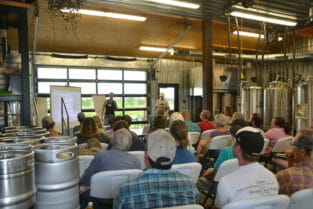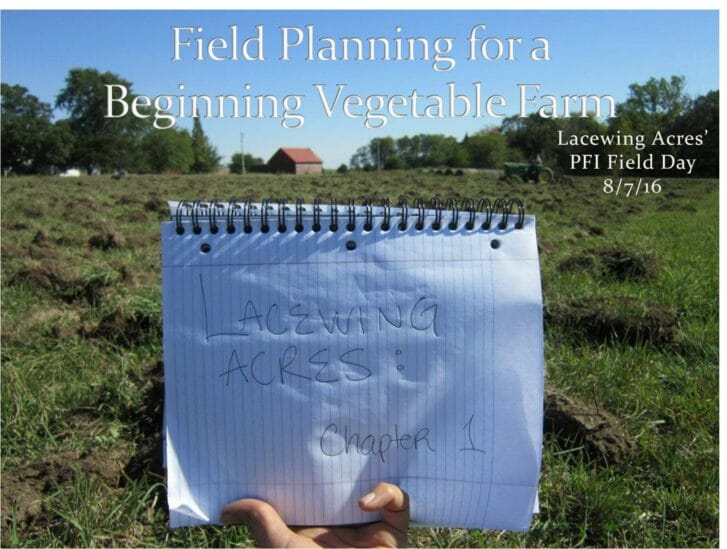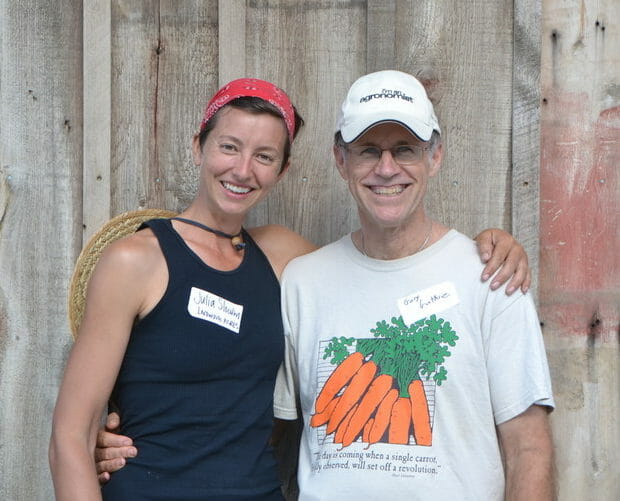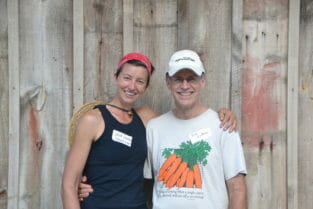Field Day Recap: Field Planning for a Beginning Vegetable Farm
Perhaps a whopping 85 people showed up to this field day because beginning vegetable growers are eager to learn what issues need to be considered when spatially setting up a vegetable farm. Perhaps the large turnout was due to PFI having more members in Story County than any of Iowa’s other 98 counties. Maybe Julia has a large network of friends, peers and customers who just want to support her and tour the farm. Or the high attendance could have been influenced by the fact that this field day was held at a farm that shared space with a brewery and winery. The truth is, if you talked to enough people that day, the answer was all of the above.

The first portion of the field day was held in the back of Alluvial Brewery, and the large crowd had some of us peering around kegs and fermentation vessels.
Regardless of any other explanations, we knew this was a topic beginning farmers wanted to hear about, and Julia Slocum of Lacewing Acres in Ames was happy to share her knowledge. We wanted her to discuss how she spatially setup her 3-acre plot of fruits and vegetables, and how this is related to her tillage, weeding, crop rotation and other production considerations. She joked that it might be a presentation on learning from her experiences of what not to do—and at times it was—but what better way for beginners to learn than from other’s mistakes?? After the field day, though, it was clear that Julia has spent a lot of time thinking about how to set up her farm. She has sought out resources and learning opportunities, reflected on her own experiences, and is constantly improving her system to fit her circumstances.
This year is Julia’s fourth growing season managing her own farm, Lacewing Acres, and second year at her current location on the property of Alluvial Brewery. She rents a 3 acre plot that is certified organic, selling her produce primarily through a community supported agriculture program as well as a handful of restaurant and wholesale outlets. You can read more about the history of Lacewing Acres and how Julia came to be a farmer on her website.
Joining Julia for the discussion on field configuration for a vegetable farm was Gary Guthrie, owner and operator of Growing Harmony Farm near Nevada. Gary was Julia’s mentor when she participated in PFI’s Savings Incentive Program, and throughout the day he offered insight from over 20 years of production experience (learn more about the Savings Incentive Program here–applications open for the next class on August 22nd).
After an introduction from both farmers, Julia jumped right into a presentation describing her practices, her rationale and process for arriving at those practices, and resources for attendees to do their own research (click the photo below for a PDF of her presentation). Following the classroom portion of the day we wandered out through Julia’s fields to see examples of what we just talked about. Throughout all of this, not only did Julia use Gary’s experience to offer alternative methods to hers, but she continually asked attendees to offer their insight, explaining “there’s not really a right or wrong way to do it, there are just pros and cons to each way.”
Here are a couple points from most of the topics they covered:
- Leave yourself plenty of extra space! You’ll need it for turning equipment around, possibly re-planting or relay-planting, and future growth.
- Measure your equipment! Know the width of your tractor straddle and what spacing you need between rows (Julia generally uses 3 rows, 12” apart, with 6” on either shoulder). Also know the width of your mower deck for easy mowing of paths and fences.
- Record your crop successions and plan a rotation! Rotations help manage weeds, diseases, pests and nutrients (Julia’s simplified rotation is allium-> brassica-> solanacea-> cucurbit-> allium)
- Intercropping (two crop types planted together) and relay cropping (one crop followed by another) can be helpful but may cause problems with timing.
- Incorporate cover crops into your plan! Know your cover crop objectives and what varieties accomplish those, and keep it simple until you’re comfortable. (Julia uses rye, oats, peas and clover) (Gary says every field has a “weed bank” and properly managing cover crops and staying on-top of weeding during the field’s first 3 years of production will lower that field’s weed bank.)
After our field tour, Julia had her equipment on display and described what tools she uses for certain tasks. She owns a cultivating tractor and rents a 45 hp Kabota tractor from the winery, she uses a riding lawnmower, various hoes, a broadfork, a spinning jenny for rowcover, a backpack sprayer for surround, a 3-way earthway seeder, a salad spinner and plenty of other hand tools.
Standing out in the field we listened to some final thoughts from Julia about the evolution of her washing and packing station, as well as her cooler system and rental arrangement with the property owners. Before heading back to the brewery to enjoy the potluck and maybe a cold pint of beer, Gary wrapped things up with some concluding thoughts about getting started in vegetable production:
“It took me about 5 years before I was hitting my stride with my systems and rotations… There’s a lot of decisions you have to make depending on what you want to do and how to spend your time. You’ve seen a good example of a working farm in progress, that every year will get better and better as you get your systems down.” Making the point that his farm, goals, and his life circumstances are much different than Julia’s or anyone else’s, he left us with some words of wisdom: “Learn from other farmers, but don’t compare yourself to other farmers.”
A big thank-you to Julia for hosting a field day when we needed a location change (despite her being short-staffed and in the middle of moving into a new home), thank you to Gary for offering his insight, thank you to Alluvial for allowing us to use their facilities, and of course thank you to our sponsor for the field day, Iowa Farmers Union!



